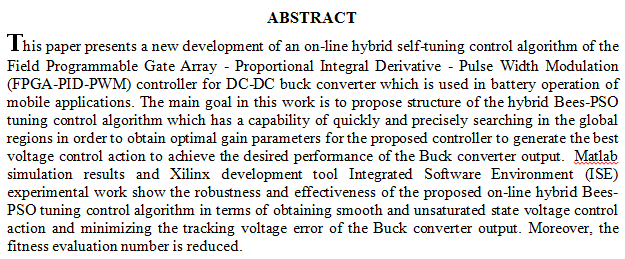
In this research tri metal oxides were fabricated by simple chemical spray pyrolysis technique from (Sn(NO3)2.20 H2O, Zn(NO3)2.6 H2O, Cd(NO3)2.4 H2O) salts at concentration 0.1M with mixing weight ratio 50:50 were fabricated on silicon substrate n-type (111). (with & without the presence of grooves by the following diemensions (20μm width, 7.5μm depth) with thickness was about ( 0.1 ±0.05 µm) using water soluble as precursors at a substrate temperature 550 ºC±5, with spray distance (15 cm) and their gas sensing properties toward H2S gas at different concentrations (10,50,100,500 ppmv) in air were investigated at room te
... Show More (2)
(2)
 (10)
(10)
 (10)
(10)
Beryllium Zinc Oxide (BexZn1-xO) ternary nano thin films were deposited using the pulsed laser deposition (PLD) technique under a vacuum condition of 10-3 torr at room temperature on glass substrates with different films thicknesses, (300, 600 and 900 nm). UV-Vis spectra study found the optical band gap for Be0.2Zn0.8O to be (3.42, 3.51 and 3.65 eV) for the (300, 600 and 900nm) film thicknesses, respectively which is larger than the value of zinc oxide ZnO (3.36eV) and smaller than that of beryllium oxide BeO (10.6eV). While the X-ray diffraction (XRD) pattern analysis of ZnO, BeO and Be 0.2 Zn 0.8 O powder and nano-thin films indicated a hexa
... Show More (1)
(1)
This study includes synthesis of some nitrogenous heterocyclic compounds linked to amino acid esters or heterocyclic amines that may have a potential activity as antimicrobial and/or cytotoxic. Quinolines are an important group of organic compounds that possess useful biological activity as antibacterial, antifungal and antitumor .8-Hydroxyquinoline (8-HQ) and numerous of its derivatives exhibit potent activities against fungi and bacteria which make them good candidates for the treatment of many parasitic and microbial infection diseases.
These pharmacological properties of quinolones aroused our interest in synthesizing several new compounds featuring heterocyclic rings of the quinoline derivatives linke
... Show More (1)
(1)
In this work, nanostructure zinc sulfide (ZnS) thin films at temperature of substrate 450 oC and thickness (120) nm have been produced by chemical spray pyrolysis method. The X-Ray Diffraction (XRD) measurements of the film showed that they have a polycrystalline structure and possessed a hexagonal phase with strong crystalline orientation of (103). The grain size was measured using scanning electron microscope (SEM) which was approximately equal to 80 nm. The linear optical measurements showed that ZnS nanostructure has direct energy gap. Nonlinear optical properties experiments were performed using Q-switched 532 nm Nd:YAG laser Z-scan system. The nonlinear refractive index (n2) and nonlinear absorption coefficient (β) estimated for Z
... Show MoreBACKGROUND: CRC is one of the most common cancers in the world. K-ras is proto-oncogene with GTPase activity that is lost when the gene is mutated. Analysis of K-ras mutational status is very important for CRC treatment, being the most important predictors of resistance to targeted therapy. OBJECTIVE: This study aims to determine the frequency and spectrum of K-ras mutation among Iraqi patients with sporadic CRC. PATIENTS, MATERIALS AND METHODS: This study enrolled 35 cases with sporadic CRC; their clinicopathological parameters were analyzed. The FFPE blocks were used for DNA extraction; PCR amplification of K-ras gene and hybridization of allele-specific oligoprobes were performed. The assay covers 29 mutations in the K-ras gene (codons 1
... Show MoreMoisture damage is described as a reduction in stiffness and strength durability in asphalt mixtures due to moisture. This study investigated the influence of adding nano silica (NS) to the Asphalt on the moisture susceptibility of hot-mix-asphalt (HMA) mixtures under different aging conditions. NS was mixed with asphalt binder at concentrations of 2%, 4%, and 6% by weight of the binder. To detect the microstructure changes of modified Asphalt and estimate the dispersion of NS within the Asphalt, the field emission scanning electron microscope (FE-SEM) was used. To examine the performance of Asphalt mixed with NS at different aging stages (short-term and long-term aging), asphalt mixture tests such as Marshall stability,
... Show More (10)
(10)
Background: Adipose derived-mesenchymal stem cells have been used as an alternative to bone marrow cells in this study. Objective: We investigated the in vitro isolation, identification, and differentiation of stem cells into neuron cells, in order to produce neuron cells via cell culture, which would be useful in nerve injury treatment. Method: Mouse adipose mesenchymal stem cells were dissected from the abdominal subcutaneous region. Neural differentiation was induced using β-mercaptoethanol. This study included two different neural stage markers, i.e. nestin and neurofilament light-chain, to detect immature and mature neurons, respectively. Results: The immunocytochemistry results showed that the use of β-mercaptoethanol resulted in
... Show More (4)
(4)
Roller Compacted Concrete is a type of concrete that is environmentally friendly and more economical than traditional concrete. Roller Compacted Concrete is typically used for heavy-duty and specialist constructions, such as hydraulic structures and pavements, because of its coarse surface. The main difference between RCC and conventional concrete mixtures is that RCC has a more significant proportion of fine aggregates that allow compaction and tight packing. In recent years, it has been estimated that several million tons of waste demolished material (WDM) produced each year are directed to landfills worldwide without being recycled for disposal. This review aimed to study the literature about creating a Roller-Comp
... Show More (1)
(1)
Undoped and Co-doped zinc oxide (CZO) thin films have been prepared by spray pyrolysis technique using solution of zinc acetate and cobalt chloride. The effect of Co dopants on structural and optical properties has been investigated. The films were found to exhibit maximum transmittance (~90%) and low absorbance. The structural properties of the deposited films were examined by x-ray diffraction (XRD). These films, deposited on glass substrates at (400? C), have a polycrystalline texture with a wurtzite hexagonal structure, and the grain size was decreased with increasing Co concentration, and no change was observed in lattice constants while the optical band gap decreased from (3.18-3.02) eV for direct allowed transition. Other parameters
... Show More